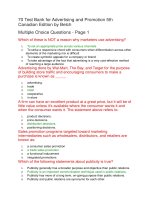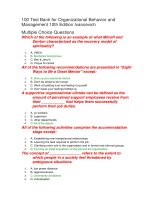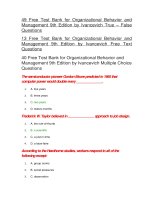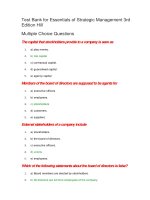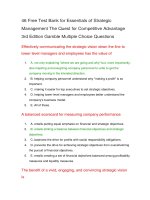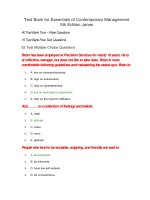Test bank for concepts in strategic management canadian edition 1st edition wheelen
Bạn đang xem bản rút gọn của tài liệu. Xem và tải ngay bản đầy đủ của tài liệu tại đây (90.19 KB, 18 trang )
Test Bank for Concepts in Strategic Management
Canadian Edition 1st Edition Wheelen
Which approach to ethical behavior proposes that decision makers should
be fair and impartial in the distribution of harm and benefit to all
individuals?
1.
A) justice approach
2.
B) categorical imperatives
3.
C) moral relativism
4.
D) individual rights approach
5.
E) utilitarian approach
Which of Carroll's responsibilities of business is to follow the generally
held beliefs about appropriate behaviour in a society?
1.
A) ethical
2.
B) moral
3.
C) legal
4.
D) corporate
5.
E) fiduciary
According to the utilitarian approach, the ability to affect the company is
known as
1.
A) stability.
2.
B) legitimacy.
3.
C) power.
4.
D) urgency.
5.
E) utility.
Who said that the social responsibility of business is a "fundamentally
subversive doctrine" and that the one social responsibility of business is
"to use its resources and engage in activities designed to increase its
profits so long as it stays with the rules of the game..."?
1.
A) Archie Carroll
2.
B) Milton Friedman
3.
C) Edward Freeman
4.
D) William C. Norris
5.
E) Adam Smith
Which of Carroll's responsibilities of business is shaped by governments
in laws?
1.
A) economic
2.
B) fiduciary
3.
C) legal
4.
D) corporate
5.
E) ethical
People who are similar on relevant dimensions such as job seniority
should be treated in the same way, is an example of
1.
A) distributive justice.
2.
B) compensatory justice.
3.
C) retributive justice.
4.
D) relevant justice.
5.
E) punitive justice.
Economist Milton Friedman has argued that a business's only
responsibility is to
1.
A) sustain its market share.
2.
B) maximize profits and stay within the rules of the game.
3.
C) promote the welfare of society.
4.
D) satisfy its employees.
5.
E) satisfy its customers.
For many large organizations the typical strategic planning staff has just
fewer than how many people?
1.
A) 7.
2.
B) 3.
3.
C)10.
4.
D)5.
5.
E)15.
Leaders who are able to command respect and influence strategy
formulation and implementation tend to display which of the following
characteristics?
1.
A) is not easily intimidated
2.
B) older than the average age of the workforce
3.
C) highly educated
4.
D) presents a role for others to identify with and follow
5.
E) all of the above
Which of Carroll's responsibilities of business is to produce goods and
services of value to society so that the firm may repay its creditors and
provide a return to its shareholders?
1.
A) corporate
2.
B) fiduciary
3.
C) economic
4.
D) legal
5.
E) monetary
According to the text, the primary responsibilities of top management in
strategic management include
1.
A) ensuring that day to day operations are efficient and well run.
2.
B) making all important decisions.
3.
C) managing the short-term planning process.
4.
D) providing executive leadership.
5.
E) balancing the budget.
The theory that proposes corporations have responsibilities to society
that extend beyond making a profit is known as
1.
A) managerial responsibility.
2.
B) flexible responsibility.
3.
C) social management.
4.
D) social responsibility.
5.
E) social flexibility.
The following quotation is attributed to whom? "There is one and only
social responsibility of business -- to use its resources and engage in
activities designed to increase profits."
1.
A) Michael Porter
2.
B) Immanuel Kant
3.
C) Lawrence Kohlberg
4.
D) Milton Friedman
5.
E) Archie Carroll
Issues in affirmative action such as reverse discrimination are examples
of conflicts between
1.
A) compensatory and punitive justice.
2.
B) retributive and distributive justice.
3.
C) punitive and retributive justice.
4.
D) distributive and compensatory justice.
5.
E) retributive and distributive justice.
Carroll's four responsibilities of business, in order of priority, are:
1.
A) fiduciary, economic, legal, ethical
2.
B) ethical, legal, economic, discretionary
3.
C) legal, economic, ethical, discretionary
4.
D) fiduciary, legal, economic, ethical
5.
E) economic, legal, ethical, discretionary
A code of ethics:
1.
A) is usually sufficient to ensure individuals act ethically
2.
B) signals confidence and trustworthiness to the market
3.
C) is an ineffective tool for organizations to encourage ethical behavior
4.
D) creates a culture of ethics
5.
E) none of the above
In turbulent environments, the best type of planning is ____
1.
A) horizontal strategic planning
2.
B) top-down strategic planning.
3.
C) composite strategic planning.
4.
D) bottom-up strategic planning.
5.
E) monopolistic strategic planning.
Strategic planning staff are usually responsible for which of the following:
1.
A) identify and analyze company-wide strategic issues
2.
B) guide business units through the strategic planning process
3.
C) supporting top management and business units
4.
D) suggest strategic alternatives to top management
5.
E) all of the above
Which one of the following is NOT one of the arguments against social
responsibility as used by economist Milton Friedman?
1.
2.
A) Spending money for social responsibility is spending the stockholder's money
for a general social interest.
B) Businesses can actually do very little in terms of social responsibility.
3.
C) There is one and only one social responsibility of business -- to use its
resources and engage in activities designed to increase its profits so long as it
stays within the rules of the game.
4.
D) Through taking on the burden of social costs, the organization becomes less
efficient, causing price increases or postponement of growth.
5.
E) Spending money on social responsibility is acting from motives other than
economic and may, in the long-run, cause harm to the very society the firm is trying
to help.
The belief in the acceptability of a certain condition or decision, usually
judged in comparison with some other conditions or decisions, is called
a/an:
1.
A) value
2.
B) moral
3.
C) culture
4.
D) responsibility
5.
E) attitude
According to Immanuel Kant's categorical imperatives:
1.
A) a behavior is ethical if everyone in a similar situation would do the same thing
2.
B) do not restrict people's actions so that they are left disadvantaged in some way
3.
C) people treat others as they would like to be treated themselves
4.
D) don't treat people as a means to an end
5.
E) all of the above
According to Carroll, the responsibility that management of a business
organization assumes which are purely voluntary obligations are
1.
A) legal responsibilities.
2.
B) financial responsibilities.
3.
C) ethical responsibilities.
4.
D) discretionary responsibilities.
5.
E) economic responsibilities.
Ethics is defined as
1.
A) voluntary obligations assumed by an individual or organization.
2.
B) formal codes that permit or forbid certain behaviors.
3.
C) a general rule of conduct of personal behavior, based on religious or
philosophical grounds.
4.
D) beliefs about standards of behavior for an occupation, trade, or profession.
5.
E) imposing one's morality upon another.
The approach to ethical behavior which proposes that decision makers be
equitable, fair, and impartial in the distribution of costs and benefits to
individuals and groups is called
1.
A) utilitarian approach.
2.
B) individual rights approach.
3.
C) justice approach.
4.
D) moral imperialism approach.
5.
E) mercantilism approach.
According to Kohlberg, the third level of moral development,
characterized by a person's adherence to an internal moral code, is called
1.
A) conventional.
2.
B) essential.
3.
C) preconventional.
4.
D) principled.
5.
E) fundamental.
According to the utilitarian approach, legal or moral claim on company
resources can stand for
1.
A) stability.
2.
B) power.
3.
C) utility.
4.
D) legitimacy.
5.
E) urgency.
According to Carroll, the responsibility that management of a business
organization has to produce goods and services of value to society so
that the firm may repay its creditors and stockholders is called
1.
A) ethical responsibilities.
2.
B) legal responsibilities.
3.
C) discretionary responsibilities.
4.
D) economic responsibilities.
5.
E) financial responsibilities.
The type of justice which proposes that punishment should be determined
on a proportional basis to the "crime" is called
1.
A) punitive justice.
2.
B) retributive justice.
3.
C) compensatory justice.
4.
D) distributive justice.
5.
E) relevant justice.
According to Kohlberg, the second level of moral development,
characterized by considerations of society's laws and norms, is called
1.
A) principled.
2.
B) fundamental.
3.
C) essential.
4.
D) preconventional.
5.
E) conventional.
The type of justice which argues that wrongs should be compensated in
proportion to the offense suffered is called
1.
A) retributive justice.
2.
B) punitive justice.
3.
C) relevant justice.
4.
D) distributive justice.
5.
E) compensatory justice.
Examining the justice approach, reverse discrimination is an example of
the conflict that exists between
1.
A) agency and legitimacy.
2.
B) power and urgency.
3.
C) power and legitimacy.
4.
D) legitimacy and urgency.
5.
E) distributive and compensatory justice.
When a private speculator purchases the right to a valuable corporate
brand name domain and then sells it to the company at an exorbitant
price, this practice is referred to as
1.
A) cyberpatenting.
2.
B) cybersquatting.
3.
C) cybertampering.
4.
D) cybercopying.
5.
E) cyberstealing.
Organizations feel which of the following pressures to act ethically and
responsibility?
1.
A) pressure from public interest groups
2.
B) their own values and morals
3.
C) a desire for a good reputation in the market
4.
D) a concern with appearing proper in the eyes of the public
5.
E) all of the above
A description of what the company is capable of becoming is referred to
as
1.
A) strategic familiarity.
2.
B) strategic concept.
3.
C) strategic flexibility.
4.
D) strategic vision.
5.
E) strategic mission.
A problem with the utilitarian approach is
1.
A) that it is difficult to recognize all the benefits and costs of any particular
decision.
2.
B) that it imposes one's morality upon others and judges them by standards they
may or may not accept.
3.
C) that it imposes a set of mandatory values and behaviors on all entities in
society.
4.
5.
D) that it encourages selfish behavior.
E) that it assumes all countries subscribe to the same definition of "fundamental
rights."
The term "social responsibility" can be viewed as a combination of an
1.
A) organization's ethical and discretionary responsibilities.
2.
B) organization's financial and economic responsibilities.
3.
C) organization's legal and ethical responsibilities.
4.
D) organization's legal and discretionary responsibilities.
5.
E) organization's economic and ethical responsibilities.
Ben & Jerry's Ice Cream is a company that is known for is environmental
concerns. This has allowed them to
1.
A) charge premium prices and gain brand loyalty
2.
B) pay workers less because they prefer to work for a responsible firm
3.
C) generate enduring relationships with distributors
4.
D) expand quickly into South Africa once apartheid ended
5.
E) none of the above
Which approach to ethical behavior proposes that actions and plans be
judged by their consequences?
1.
A) justice approach
2.
B) moral relativism
3.
C) individual rights approach
4.
D) utilitarian approach
5.
E) categorical imperatives
Which of Carroll's responsibilities of business are purely voluntary ones
an organization assumes?
1.
A) ethical
2.
B) fiduciary
3.
C) discretionary
4.
D) legal
5.
E) moral
The reaction to Nortel's decision to move production out of Canada to
lower-wage location in Asia indicates:
1.
A) the interests of different stakeholder groups can conflict with another's
2.
B) the functioning of categorical imperatives
3.
C) top management's lack of business ethics
4.
D) Nortel's preconventional level of moral development
5.
E) all of the above
The approach to ethical behavior which proposes that actions and plans
should be judged by their consequences, thus producing the greatest
benefit to society with the least harm or the lowest cost is called
1.
A) utilitarian approach.
2.
B) mercantilism approach.
3.
C) individual rights approach.
4.
D) moral imperialism approach.
5.
E) justice approach.
According to Kohlberg, in what stage of moral development do the
majority of people in the U.S. occupy?
1.
A) fundamental stage
2.
B) essential stage
3.
C) conventional stage
4.
D) preconventional stage
5.
E) principled stage
Which approach to ethical behavior proposes that human being have
certain fundamental rights that should be respected in all decisions?
1.
A) categorical imperatives
2.
B) moral relativism
3.
C) utilitarian approach
4.
D) justice approach
5.
E) individual rights approach
According to Kohlberg, the first level of moral development, characterized
by concern for self, is called
1.
A) conventional.
2.
B) preconventional.
3.
C) principled.
4.
D) fundamental.
5.
E) essential.
Increased Internet usage is raising new ethical issues because:
1.
2.
A) sellers are no longer constrained by national borders
B) domestic businesses often cannot compete with large electronic commerce
organizations
3.
C) taxing products sold on the Internet is impossible
4.
D) information available on the Internet can easily be used to defraud innocent
people
5.
E) the Internet is usually highly regulated in every country, but regulations differ
substantially
Managers who want to improve ethical behavior should take actions such
as
1.
A) encourage a culture of ethics within the organization.
2.
B) communicate the code of ethics in training programs.
3.
C) emphasize the code of ethics in performance appraisal systems.
4.
D) follow a code of ethical behavior themselves.
5.
E) all of the above
Which of the following is NOT a key characteristic of effective executive
leadership?
1.
A) The CEO energizes the board to formulate strategy.
2.
B) The CEO presents a role for others to identify with and to follow.
3.
C) The CEO articulates a strategic vision for the corporation.
4.
D) The CEO communicates high performance standards for all employees.
5.
E) The CEO demonstrates confidence in the employees' abilities to meet the
expressed high standards.
Some people claim that morality is relative to some personal, social, or
cultural standard and that there is no method for deciding whether one
decision is better than another. This is called
1.
A) moral philosophy.
2.
B) moral relativism.
3.
C) cultural imperialism.
4.
D) comparative ethics.
5.
E) ethical relativity.
The approach to ethical behavior which proposes that human beings have
certain fundamental rights that should be respected in all decisions, thus
avoiding interfering with the rights of others who might be affected by a
particular decision or behavior is called
1.
A) justice approach.
2.
B) individual rights approach.
3.
C) mercantilism approach.
4.
D) utilitarian approach.
5.
E) moral imperialism approach.
All of the following reasons provide rationale for unethical behavior
EXCEPT
1.
A) agreement among stakeholders and business people about what is ethical.
2.
B) the impact of cultural norms and values.
3.
C) difficulty of one group to understand another's actions.
4.
D) differences in values between business people and key stakeholders.
5.
E) relativity with regard to morality.
True - False Questions
Discretionary responsibilities are voluntary obligations a corporation
assumes
1.
True
2.
False
Moral relativism could enable a person to justify almost any decision or
action, as long as it is not declared illegal.
1.
True
2.
False
Executive leadership is the directing of activities toward the
accomplishment of corporate objectives
1.
True
2.
False
A moral relativist would act according to Immanuel Kant's categorical
imperatives
1.
True
2.
False
Usually, the strategic planning staff is charged with supporting only top
management in the strategic planning process
1.
True
2.
False
Immaneul Kant's principle of the categorical imperative is based in part on
the golden rule, treating others as you would like to be treated yourself
1.
True
2.
False
Refusing to treat other people as a means to an end is a sign of principled
moral development
1.
True
2.
False
The theory of vital responsibility proposes that a private corporation has
responsibilities to society that extend beyond making a profit
1.
True
2.
False
There is no worldwide standard for the conduct of business
1.
True
2.
False
Organizations are pressured to act ethically primarily because of
economics (it makes good business sense to act ethically)
1.
True
2.
False
Reebok International requires its suppliers to adhere to a strict set of
human rights production standards
1.
True
2.
False
A utilitarian approach to ethics judges decisions by the fairness of the
process by which they are made.
1.
True
2.
False
Stakeholders are all constituencies that are affected by the achievement
of the firm's objectives
1.
True
2.
False
Kohlberg places most people at the conventional level of moral
development.
1.
True
2.
False
Archie Carroll proposes that managers in companies have only a
discretionary responsibility
1.
True
2.
False
Kohlberg's highest level of moral development is the conventional level.
1.
True
2.
False
The belief that morality is solely individually based and subjective is
based on the philosophy of Immanuel Kant
1.
True
2.
False
Consumers reward ethical organizations by giving them more business
than organizations they view as unethical
1.
True
2.
False
A study concerning social responsibility indicates that sociallyresponsible firms are more likely to be welcomed into another country
1.
True
2.
False
A code of ethics is usually sufficient to encourage ethical behavior in
organizations
1.
True
2.
False
